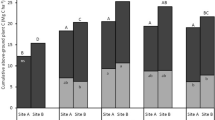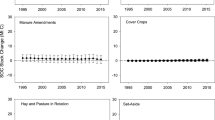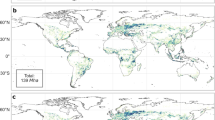Abstract
The effects of land-use change (LUC) on soil carbon (C) balance has to be taken into account in calculating the CO2 savings attributed to bioenergy crops1,2,3. There have been few direct field measurements that quantify the effects of LUC on soil C for the most common land-use transitions into sugar cane in Brazil, the world’s largest producer 1,2,3. We quantified the C balance for LUC as a net loss (carbon debt) or net gain (carbon credit) in soil C for sugar-cane expansion in Brazil. We sampled 135 field sites to 1 m depth, representing three major LUC scenarios. Our results demonstrate that soil C stocks decrease following LUC from native vegetation and pastures, and increase where cropland is converted to sugar cane. The payback time for the soil C debt was eight years for native vegetation and two to three years for pastures. With an increasing need for biofuels and the potential for Brazil to help meet global demand4, our results will be invaluable for guiding expansion policies of sugar-cane production towards greater sustainability.
This is a preview of subscription content, access via your institution
Access options
Subscribe to this journal
Receive 12 print issues and online access
$209.00 per year
only $17.42 per issue
Buy this article
- Purchase on Springer Link
- Instant access to full article PDF
Prices may be subject to local taxes which are calculated during checkout



Similar content being viewed by others
References
Fargione, J., Hill, J., Tilman, D., Polasky, S. & Hawthorne, P. Land clearing and the biofuel carbon debt. Science 319, 1235–1238 (2008).
Lapola, D. M. et al. Indirect land-use changes can overcome carbon savings from biofuels in Brazil. Proc. Natl Acad. Sci. USA 107, 3388–3393 (2010).
Gibbs, H. K. et al. Carbon payback times for crop-based biofuel expansion in the tropics: the effects of changing yield and technology. Environ. Res. Lett. 3, 034001 (2008).
Goldemberg, J., Mello, F. F. C., Cerri, C. E. P., Davies, C. A. & Cerri, C. C. Meeting the global demand for biofuels in 2021 through sustainable land use change policy. Energy Policy 69, 14–18 (2014).
FAO—Food and Agriculture Organization of the United Nations (FAOSTAT, 2013; http://faostat.fao.org)
Brazil-Ministry of Mines and Energy—Empresa de Pesquisa Energética, Balanço Energético Nacional 2013 - Ano base 2012 (EPE Publication, 2013); https://ben.epe.gov.br/BENRelatorioFinal2013.aspx
Fearnside, P. M. et al. Biomass and greenhouse-gas emissions from land-use change in Brazil’s Amazonian arc of deforestation: The states of Mato Grosso and Rondônia. Forest Ecol. Manage. 258, 1968–1978 (2009).
Cerri, C. E. P. et al. Predicted soil organic carbon stocks and changes in the Brazilian Amazon between 2000 and 2030. Agric. Ecosyst. Environ. 122, 58–72 (2007).
Lal, R. Soil carbon sequestration impacts on global climate change and food security. Science 304, 1623–1627 (2004).
Smith, P. et al. Towards an integrated global framework to assess the impacts of land use and management change on soil carbon: Current capability and future vision. Glob. Change Biol. 18, 2089–2101 (2012).
Rudorff, B.F.T et al. Studies on the rapid expansion of sugarcane for ethanol production in São Paulo state (Brazil) using landsat data. Remote Sensing 2, 1057–1076 (2010).
CONAB – Companhia Nacional de Abastecimento ‘National Supply Company’. Acompanhamento de safra brasileira: cana-de-açúcar, primeiro levantamento, abril/2009 [in Portuguese]. (Companhia Nacional de Abastecimento, 2009)
Adami, M. et al. Remote sensing time series to evaluate direct land use change of recent expanded sugarcane crop in Brazil. Sustainability 4, 574–585 (2012).
Galford, G. L. et al. Greenhouse gas emissions from alternative futures of deforestation and agricultural management in the southern Amazon. Proc. Natl Acad. Sci. USA 107, 19649–19654 (2010).
Cerri, C. C. et al. Greenhouse gas emissions: The importance of agriculture and livestock. Sci. Agric. 66, 831–843 (2009).
Galdos, M. V., Cerri, C. C. & Cerri, C. E. P. Soil carbon stocks under burned and unburned sugarcane in Brazil. Geoderma 153, 347–352 (2009).
Fearnside, P. M. & Barbosa, R. I. Soil carbon changes from conversion of forest to pasture in Brazilian Amazonia. Forest Ecol. Manage. 108, 147–166 (1998).
Grace, J., San Jose, J., Meir, P. & Miranda, S. M. Productivity and carbon fluxes of tropical savannas. J. Biogeogr. 33, 387–400 (2006).
Silva-Olaya, A. M. et al. Carbon dioxide emissions under different soil tillage systems in mechanically harvested sugarcane. Environ. Res. Lett. 8, 1–8 (2013).
Intergovernmental Panel on Climate Change (IPCC), in IPCC Guidelines for National Greenhouse Gas Inventories: Prepared by the National Greenhouse Gas Inventories Programme (eds Eggleston, H. S., Buendia, L., Miwa, K., Ngara, T. & Tanabe, K.) (Institute for Global Environmental Strategies, 2006).
Maia, S. M. F., Ogle, S. M., Cerri, C. E. P. & Cerri, C. C. Effect of grassland management on soil carbon sequestration in Rondônia and Mato Grosso states, Brazil. Geoderma 149, 84–91 (2009).
Zinn, Y. L., Lal, R. & Resck, D. V. S. Changes in soil organic carbon stocks under agriculture in Brazil. Soil Tillage Res. 84, 28–40 (2005).
Maia, S. M. F., Ogle, S. M., Cerri, C. C. & Cerri, C. E. P. Changes in soil organic carbon storage under different agricultural management systems in the Southwest Amazon Region of Brazil. Soil Tillage Res. 106, 177–184 (2010).
Rangel, T. F. Amazonian extinction debts. Science 337, 162–163 (2012).
Isbell, F. et al. High plant diversity is needed to maintain ecosystem services. Nature 477, 199–202 (2011).
Davidson, E. A. et al. The Amazon basin in transition. Nature 481, 321–328 (2012).
Foley, J. A. et al. Solutions for a cultivated planet. Nature 478, 337–342 (2011).
Renewable Energy Policy Network for the 21st Century Renewable 2013 Global Status Report (REN 21 secretariat, 2013); http://www.ren21.net/REN21Activities/GlobalStatusReport.aspx
Chu, S. & Majumdar, A. Opportunities and challenges for a sustainable energy future. Nature 488, 294–303 (2012).
Ogle, S. M., Conant, R. T. & Paustian, K. Deriving grassland management factors for a carbon accounting method developed by the intergovernmental panel on climate change. Environ. Manage. 33, 474–484 (2004).
Ogle, S. M., Breidt, F. J. & Paustian, K. Agricultural management impacts on soil organic carbon storage under moist and dry climatic conditions of temperate and tropical regions. Biogeochemistry 72, 87–121 (2005).
Acknowledgements
We thank São Paulo Research Foundation — FAPESP (2011/ 07105-7), Shell Global Solutions (UK), Brazilian Bioethanol Science and Technology Laboratory — CTBE for financial support. We thank all sugar-cane mills, associations and individual farmers who supported the soil sampling and provided access to field work. We also thank B. Ide and E.C. Reidel for their valuable help in finding the comparison pairs and G. Ferrão for support and fieldwork organization. F.F.C.M. wishes to thank W. Clark, N. Dickson and the Sustainability Science Program at the John F. Kennedy School of Government, Harvard University, for help and guidance during the writing and analysis process, and CAPES, CNPq and the Italian Ministry for Environment, Land and Sea for the scholarship granted while this research paper was developed.
Author information
Authors and Affiliations
Contributions
F.F.C.M., C.E.P.C., C.C.C. and C.A.D. designed the study and conducted the analyses. S.M.F.M. and K.P. developed the model to determine the LUC factors for sugar cane. All the authors contributed to writing the paper.
Corresponding author
Ethics declarations
Competing interests
The authors declare no competing financial interests.
Supplementary information
Rights and permissions
About this article
Cite this article
Mello, F., Cerri, C., Davies, C. et al. Payback time for soil carbon and sugar-cane ethanol. Nature Clim Change 4, 605–609 (2014). https://doi.org/10.1038/nclimate2239
Received:
Accepted:
Published:
Issue Date:
DOI: https://doi.org/10.1038/nclimate2239
This article is cited by
-
Sugarcane cultivation altered soil nitrogen cycling microbial processes and decreased nitrogen bioavailability in tropical Australia
Journal of Soils and Sediments (2024)
-
Implications of regional agricultural land use dynamics and deforestation associated with sugarcane expansion for soil carbon stocks in Brazil
Regional Environmental Change (2022)
-
Brazil’s sugarcane embitters the EU-Mercosur trade talks
Scientific Reports (2021)
-
Water Consumption Modeling by Coupling MODIS Images and Agrometeorological Data for Sugarcane Crops
Sugar Tech (2021)
-
Modelling the potential for soil carbon sequestration using biochar from sugarcane residues in Brazil
Scientific Reports (2020)



